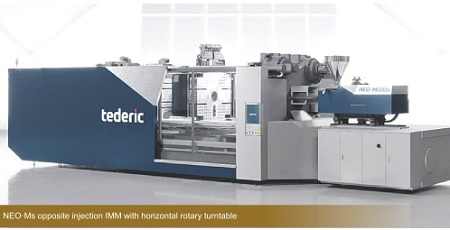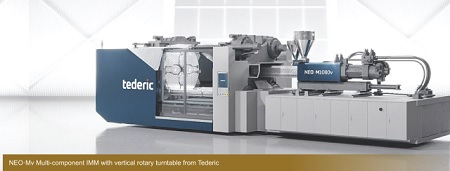Multi-shot injection moulding, sometimes known as twin-shot or two-shot injection moulding, is a process where two or more resin types and colours are injected at the same time into a mould to create one or multiple components. This technique is widely used in the production of plastic parts, and gives such advantages as increased production output, improved aesthetic design and value, reduced assembly of parts and the flexibility of customising the end product.
To date, twin-shot injection moulding systems available in the market are diverse as they aim to meet the various requirements that there exist several variants of this type of moulding process. Two-shot injection moulding is typically used to combine hard plastics with a softer material. Some of the common combinations of materials are PP/ABS, PC/ABS, Silicones/Thermoplastics, TPE/ Thermoplastics, Nylons/Elastomers etc. Two-shot moulding is usually applied to manufacture multi-coloured parts, soft-touch handles & grips, articulated parts such as joints and hinges and technical parts for dampening vibrations. Based on the recent report of Transparency Market Research, the global two-shot injection moulding market was valued at $6.6 billion in 2015 and is projected to reach $11.58 billion by 2024, posting CAGR of 6.5% from 2016 to 2024.
In terms of application, automotive was the largest segment of the two-shot injection moulding market, accounting for more than 20% volume share in 2015. However, the medical segment was projected to overtake the automotive segment by 2024 boosted by a fast CAGR of more than 7% from 2016 to 2024. The consumer goods and the electrical & electronics segments were also anticipated to witness growth due to increasing number of applications of two-shot injection moulding in these segments. The packaging and industrial segments were forecasted to witness below average growth rates during the forecast period. The opportunity for moulders to differentiate and add value to their products through two-shot injection moulding was the prime driver for the market. In terms of product volume, PP was the leading product segment in the two-shot injection moulding market. Silicones, TPE, nylons and polycarbonate are among the fastest growing polymers used in two-shot injection moulding.

Demand for plastics used in two-shot injection moulding is estimated to be high in developed nations. Europe dominated the two-shot injection moulding market accounting for more than 30% of the total market share in 2015. North America was another major consumer of plastics used in two-shot injection moulding. Asia Pacific is projected to grow at the fastest rate between 2016 and 2024. The major technological trends in this market is the development of two-shot moulding machines for manufacturing products requiring high tonnage as well as for products in micro dimensions, according to the Transparency Market Research report.
Engineered for excellent performance
Several Asian companies are notably scaling up their production of multi-material injection moulding systems. At Chinaplas 2021, Tederic Machinery Co. launched its all-new premium injection moulding machines under the NEO series. The range of injection moulding machines was jointly created by the Tederic team and a group of top designers from around the world, bringing together the accumulated Tederic engineering experience, with leading European design knowhow. The combination of leading industrial styling, advanced electro-mechanical design, and leading brand componentry, result in a machine with excellent performance and a premium user experience.
All machines feature an advanced Keba control, with the option of 12-inch touch, 15-inch multi-touch and 21-inch enhanced multi-touch configurations. The controllers offer support for OPC, UA and Modbus data protocols and feature free programming capabilities to accommodate a variety of special process requirements.
A new generation of servo-pumps power the system with ultra-high response speeds (max. pressure can be reached in 28ms) can save 30% to 80% energy consumption when compared to traditional hydraulic systems.
Machine guarding has been completely redesigned to align with the new Tederic brand and, aside from an aesthetically pleasing appearance, has also been engineered to be safe, practical and user friendly. All machines conform to the local safety standards in the various international markets where Tederic is sold.

The six product lines introduced include NEO·T, NEO·E, NEO·Ec, NEO·H, NEO·Mv, NEO·Ms. Of these six product lines, two are multi-material machines.
The NEO·Mv models is a range of multi-material machines that are equipped with the Spinsure-V™ vertical rotary platen integrated into the moving platen casting. These rotary platens are servo driven and offer a full range of utility connection options. Wide platen toggle machines in the range 170t to 810t and two-platen machines in the range 880t to 1920t can be configured with up to five independently controlled injection units. These units can be positioned parallel, angled, perpendicular and vertical to the main machine axis. Both hydraulic and electric injection units are available.
Another model, the NEO·Ms is a special range of multi-material machines in the range 880t to 1920t that are equipped with the Spinsure-H™ horizontal rotary table that is positioned between the fixed and moving platens and is used to rotate the centre section of a stack mould. The machine has two opposing injection units as standard, the secondary unit riding behind the moving platen. Additional injection units can be added as required. The rotary table movement and positioning is independently controlled, allowing for a range of mould designs and complex applications.
The other models from Tederic include the NEO·T, a series of servo-toggle machines in the range 90t to 4000t. New features include larger tie bar spacing, enhanced mould height and a special clamp braking system to improve mould positioning accuracy. The NEO·E, all-electric machines in the range 55t to 460t feature larger tie bar spacing, NSK linear bearing for platen guidance, standard 15-inch touch screen, latest generation motors and drives with DC bus technology. The range is available with speed injection speeds up to 500mm/sec, pressure accuracy to <1bar, excellent low-speed control. Ideally suited for precision technical, medical and high volume thin-wall applications.
The NEO·Ec is a breed of hybrid-electric machines in the range 55t to 460t. Injection, screw rotation and clamping unit are electro-mechanically driven, and there is an integrated power pack with servo-pump to power the ejectors, carriage and core pulls. The carriage has twin hydraulic pistons, and the moving platen features linear bearing guidance. A 15-inch touch screen is standard, and the machine uses the latest generation motors and drives with DC bus technology. Available with injection speeds up to 250mm/sec., the model appeals to custom moulders who desire the accuracy of the electric solution, coupled with the flexibility of the integrated hydraulics. Lastly, the NEO·H is a two-platen servo-pump machines, initially available in the range 680t to 2700t (eventually through 4000t). Several new models with larger tie bar spacing, enhanced mould daylight, and a special clamp braking system to improve mould positioning accuracy are also available. A 15-inch touch screen is standard, and the machine uses the latest generation motors and drives with DC bus technology. Available options include electric screw drive, tie bar extraction, and extended daylight with mould side-loading.














